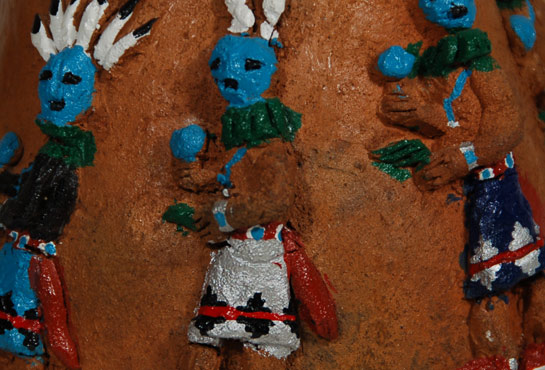Adobe Gallery Blog
Diné (Navajo) Wedding Vase with Yei and Hogan Designs by - Silas and Bertha Claw C3321E
Silas and Bertha Claw broke with Navajo pottery tradition and the customs of their fellow tradesmen. Their forms remained true to tradition but they used an appliqué technique for design elements and colorful oil or acrylic paints for highlights. They were of the Shonto/Cow Springs region of the Navajo Reservation. Silas passed away in 2002 but we have found no record of Bertha passing away.
Around 1968, Silas began working in clay even though pottery making, like basket making, was considered women's work. Bertha assisted him from the very beginning. The Claws made a variety of pottery shapes: traditional-style cooking jars, wedding vases, triple-spouted jars, and ceramic beads.
It is not known which one did which part of the production but it is believed Bertha would form the vessels and Silas would decorate them with a variety of appliquéd and incised plant and animal motifs-usually in high relief and occasionally in full round. These motifs depicted a wide range of subjects that included cactus plants and blooming yuccas, oak leaves with acorns, ears of corn, a menagerie of domestic animals, and horned toads. Silas often applied oil paint in a range of colors to portions of the appliqué to make them even more realistic. He then would coat the vessel with varnish.
This wedding vessel shows a procession of Navajo Yei dancers executed in appliqué on the body of the vessel. On the other side of the vessel is a Navajo hogan with smoke from the chimney. The wedding vessel is an older one by this couple and is signed S.B. Claw on the underside.
Condition: original condition
Provenance: from the John Barry collection of California
Recommended Reading:
- Navajo Folk Art: The People Speak by Chuck and Jan Rosenak.
- "The Navajo Pottery of Silas and Bertha Claw" by Ed Dobbins and Scott C. Russell, American Indian Art Magazine, Spring 2007. Vol. 32, No. 2.
Title: Diné (Navajo) Wedding Vase with Yei and Hogan Designs
Artists / Potters: Silas and Bertha Claw
Category: Contemporary
Origin: Diné - Navajo Nation
Medium: clay, paint
Size: 9-1/8" tall x 5" diameter
Item # C3321E


